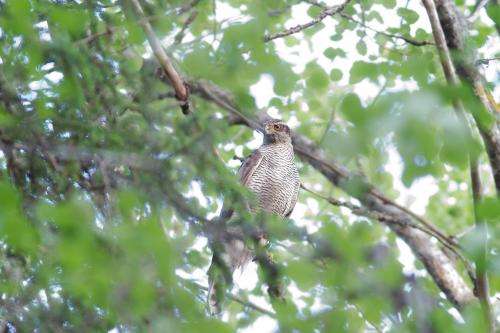Retaining forests where raptors nest can help to protect biodiversity

Raptors can affect the distribution of other species and they can also be used to find forests with high biodiversity value.
Predators influence decisions on conservation actions because they awake a remarkable interest in the society. However, favouring just predators in conservation can also mislead the scarce funding invested in nature conservation.
Researchers in the University of Helsinki and Novia University of Applied Sciences studied two common raptor species in Finland, the goshawk and the Ural owl. Researchers visited raptor nests and surrounding forests on two large forested areas and recorded the amount of biodiversity such as birds, flying squirrel and polypores around them.
The results show that because predators have a negative effect on some animal species by predation, or simply by avoidance of the predator, other species find shelter in the proximity of the raptor and are more abundant there.
"So, the raptors could be understood as an additional element on the landscape, like for example the hills, streams and ponds, that gives heterogeneity and favours biodiversity," says PhD student Daniel Burgas from the Division of Biosciences, University of Helsinki.
Raptors tell what is most cost-effective to protect
The raptors' nest sites had more birds around them than the sites without the nests. Surprisingly, the goshawk also indicated for polypore diversity.
"The results show that protecting the goshawk nest sites – which dominate over the Ural owl – provides more species for less money than with the Ural owl or other reference sites. However, the best conservation approach, if you want to protect more species with limited budgets, comes when combining the nest sites of both raptor species", Daniel Burgas explains.
The raptors perform well as indicators over large areas even when moving between different ecological regions of Finland. This means that they could tentatively be used over national scale.
Cheap tool for conservation action
The findings are especially important because, due to their charisma, several countries have extensive information on raptor nest locations. For instance, Finland is a leading country in raptor monitoring with thousands of nest locations recorded every year by volunteers all over the country. That means that there is large amount of raptor data readily available and collected free of cost for the general tax payer.
"Additionally, a study from the Finnish Natural History Museum shows that a large portion of Finnish forest owners are willing to leave aside – even without compensation – their own forest patches that have breeding raptors", Daniel Burgas says.
More information: Burgas D. "Linking raptors and biodiversity, ecological rationale and conservation relevance." Academic dissertation (article-based). University of Helsinki, Faculty of Biological and Environmental Sciences. ISBN 978-951-51-0261-4. urn.fi/URN:ISBN:978-951-51-0262-1
Provided by University of Helsinki


















